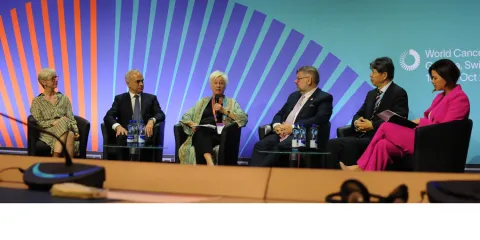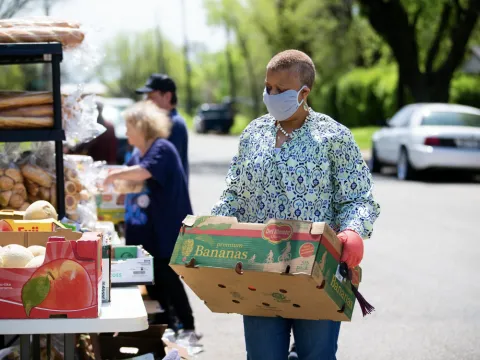Un llamado para integrar las enfermedades crónicas en la preparación y respuesta ante pandemias

-
Anne-Lise Ryel, NCDA President
Talking Points
UICC World Cancer Congress, October 2022
Plenary Session – Building Back Better for Cancer Control - Tuesday 18th October 2022
50 minute panel, 5 panellists
5 minute opening intervention
-
I’m Anne-Lise Ryel, President of the NCD Alliance, former Secretary General of the Norwegian Cancer Society, and a cancer survivor.
-
I know first-hand what goes along with living with an NCD – there is a lot of fear and anxiety. People living with cancer and other NCDs have to manage these emotions as we manage our disease on a daily basis, the best we can. But during the pandemic, for many millions of people, it all became so much harder. Why?
-
For some, NCD services were disrupted or shut down altogether. For others, their treatment became unavailable due to strained health systems and broken supply chains. For those in more remote areas, public transport stopped during lockdowns meant not being able to travel to a local clinic. Many were simply too frightened to go out and risk infection, having to isolate at home for long periods of time away from loved ones.
-
Take yourself back to the height of the pandemic in 2020 when our lives were turned upside down, and put on top of that living with cancer and not knowing if you will have access to the treatment you need to survive next month, next week, or tomorrow?
-
It was also so much harder for people living with NCDs because we were the ones who were more susceptible to developing severe COVID. People with cancer, diabetes, obesity and heart disease were and continue to be at higher risk of hospitalisation, complications and untimely death from COVID.
-
From the last 2+ years it is very clear that diseases do not respect the categories we impose on them in global health– communicable and non-communicable. An infectious coronavirus and non-communicable diseases like cancer combined and fuelled one another into a deadly mix, resulting in millions of lives lost.
-
And as is far too often the case, this deadly mix was shouldered particularly by the poorest, most vulnerable populations. Where you live, your level of deprivation, and the colour of your skin were important factors in the risk of exposure and the severity of COVID outcomes, along with access to COVID vaccines. Inequity is deadly and we have to tackle the structural factors underlying epidemics that go well beyond the medical and health sector.
-
The COVID-19 crisis continues to drag on; none of what I have said is a past tense, it is the reality today in many countries. But the long-term public health consequences – the number of undiagnosed cases stacking up, the tide of avoidable mortality from NCDs, and the impact on progress to the global NCD targets - still remain to be fully measured and understood.
-
During the pandemic, the NCD Alliance led global advocacy on linking NCDs with COVID-19 and pandemic preparedness; provided platforms for people living with NCDs to speak up and be heard; exposed how health-harming industries have capitalised on the pandemic for their own profits; and above all, provided support to our members and alliances during these challenging times.
-
But what does this all mean looking ahead, from a global policy perspective?
-
First, it means that NCDs must no longer be seen as an afterthought to pandemic preparedness and response – PPR - but as a fundamental component of resilience, security, equity, and economic stability. These 2 agendas need to be linked and connected.
-
Second, as NCDs are essentially a risk factor for severe COVID, governments must prioritise NCD prevention as a path to PPR. Investing in health promotion and prevention will create resilience against future health threats.
-
Third, health system strengthening at primary health care level. In the last 2 years we saw health systems buckling in high and low-income countries alike. Health systems must be rebuilt stronger and fairer, on the foundation of PHC and including NCDs.
-
Fourth, it will require smart and sustainable financing for NCDs, which remains an achilles heel of the response.
-
And last but no means least, community engagement. As always during health crises, civil society and community groups have played a critical role, stepping in where governments have not. So supporting, investing and making space for civil society, communities and people living with NCDs in shaping policies, services and responses, and increasing patient education, empowerment and engagement is key. Putting people first.
-
Sweeping changes were made in a matter of weeks to protect people from COVID-19. We need the same urgency now for the NCD agenda.
-
Thank you.
-
Anne-Lise Ryel, NCDA President
Talking Points
UICC World Cancer Congress, October 2022
Plenary Session – Building Back Better for Cancer Control - Tuesday 18th October 2022
50 minute panel, 5 panellists
5 minute opening intervention
-
I’m Anne-Lise Ryel, President of the NCD Alliance, former Secretary General of the Norwegian Cancer Society, and a cancer survivor.
-
I know first-hand what goes along with living with an NCD – there is a lot of fear and anxiety. People living with cancer and other NCDs have to manage these emotions as we manage our disease on a daily basis, the best we can. But during the pandemic, for many millions of people, it all became so much harder. Why?
-
For some, NCD services were disrupted or shut down altogether. For others, their treatment became unavailable due to strained health systems and broken supply chains. For those in more remote areas, public transport stopped during lockdowns meant not being able to travel to a local clinic. Many were simply too frightened to go out and risk infection, having to isolate at home for long periods of time away from loved ones.
-
Take yourself back to the height of the pandemic in 2020 when our lives were turned upside down, and put on top of that living with cancer and not knowing if you will have access to the treatment you need to survive next month, next week, or tomorrow?
-
It was also so much harder for people living with NCDs because we were the ones who were more susceptible to developing severe COVID. People with cancer, diabetes, obesity and heart disease were and continue to be at higher risk of hospitalisation, complications and untimely death from COVID.
-
From the last 2+ years it is very clear that diseases do not respect the categories we impose on them in global health– communicable and non-communicable. An infectious coronavirus and non-communicable diseases like cancer combined and fuelled one another into a deadly mix, resulting in millions of lives lost.
-
And as is far too often the case, this deadly mix was shouldered particularly by the poorest, most vulnerable populations. Where you live, your level of deprivation, and the colour of your skin were important factors in the risk of exposure and the severity of COVID outcomes, along with access to COVID vaccines. Inequity is deadly and we have to tackle the structural factors underlying epidemics that go well beyond the medical and health sector.
-
The COVID-19 crisis continues to drag on; none of what I have said is a past tense, it is the reality today in many countries. But the long-term public health consequences – the number of undiagnosed cases stacking up, the tide of avoidable mortality from NCDs, and the impact on progress to the global NCD targets - still remain to be fully measured and understood.
-
During the pandemic, the NCD Alliance led global advocacy on linking NCDs with COVID-19 and pandemic preparedness; provided platforms for people living with NCDs to speak up and be heard; exposed how health-harming industries have capitalised on the pandemic for their own profits; and above all, provided support to our members and alliances during these challenging times.
-
But what does this all mean looking ahead, from a global policy perspective?
-
First, it means that NCDs must no longer be seen as an afterthought to pandemic preparedness and response – PPR - but as a fundamental component of resilience, security, equity, and economic stability. These 2 agendas need to be linked and connected.
-
Second, as NCDs are essentially a risk factor for severe COVID, governments must prioritise NCD prevention as a path to PPR. Investing in health promotion and prevention will create resilience against future health threats.
-
Third, health system strengthening at primary health care level. In the last 2 years we saw health systems buckling in high and low-income countries alike. Health systems must be rebuilt stronger and fairer, on the foundation of PHC and including NCDs.
-
Fourth, it will require smart and sustainable financing for NCDs, which remains an achilles heel of the response.
-
And last but no means least, community engagement. As always during health crises, civil society and community groups have played a critical role, stepping in where governments have not. So supporting, investing and making space for civil society, communities and people living with NCDs in shaping policies, services and responses, and increasing patient education, empowerment and engagement is key. Putting people first.
-
Sweeping changes were made in a matter of weeks to protect people from COVID-19. We need the same urgency now for the NCD agenda.
-
Thank you.
-
-
-
Declaración de Anne Lise Ryel, presidenta de la Alianza de ENT (NCDA)
Martes 18 de octubre de 2022, Congreso Mundial del Cáncer de la UICC 2022
Gracias.
